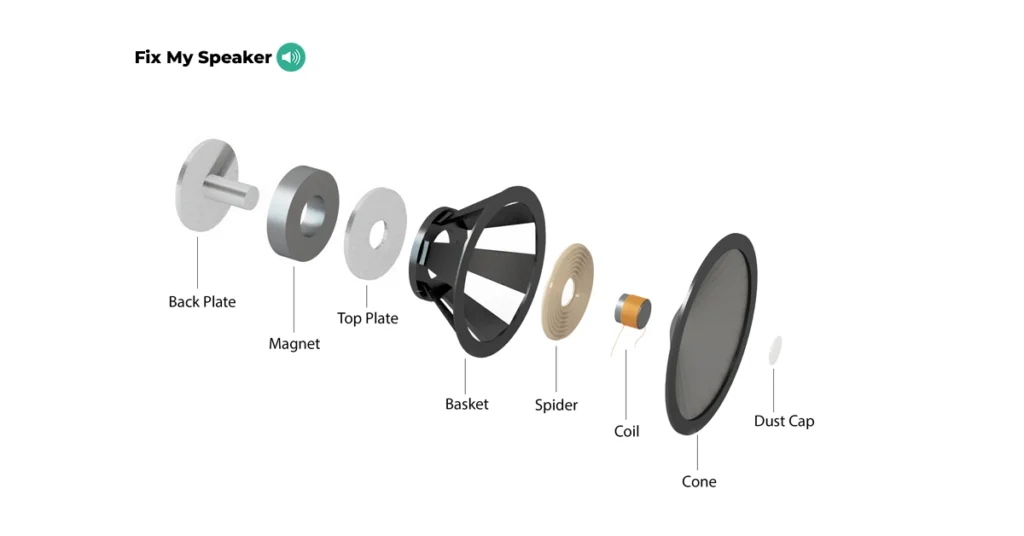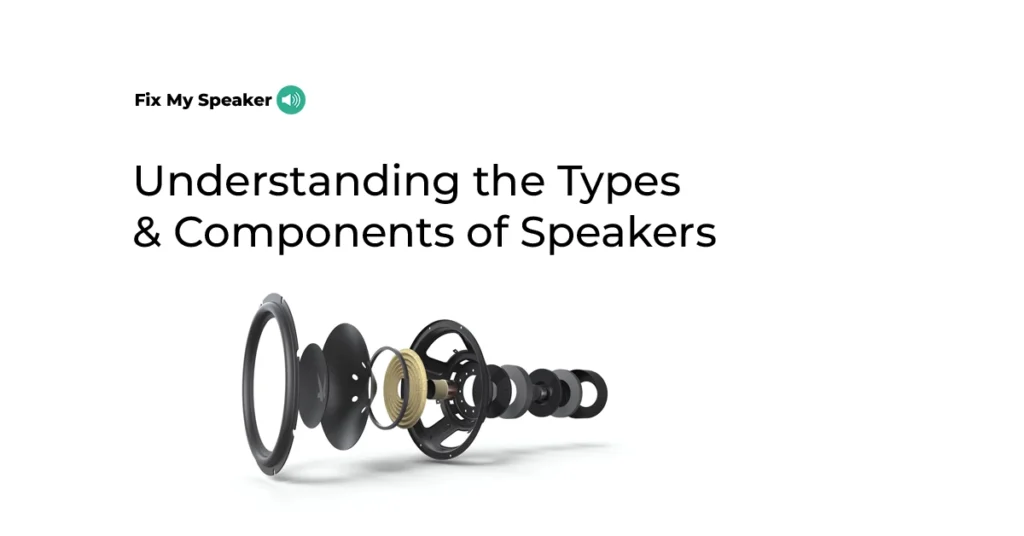Speakers are essential components in electronic devices, converting electrical signals into audible sound waves. They play a crucial role in delivering audio output in various devices, including smartphones, computers, and home entertainment systems. Understanding the types and components of speakers is fundamental for audio engineers, device manufacturers, and consumers seeking optimal sound quality.
Having Problems with your Phone Speaker Sound?
Use Our Online Fix My Speaker Tool to Fix your Phone Speaker without spending a penny.
What Are the Different Types of Phone Speakers?
What are phone speakers?
Phone speakers are audio output devices integrated into mobile phones to produce sound. They convert electrical signals from the phone’s audio processing system into audible sound waves. Key features of phone speakers include:
- Compact size: Designed to fit within the limited space of a smartphone
- Energy efficiency: Optimized to minimize battery consumption
- Frequency response: Typically range from 20 Hz to 20 kHz, covering the human audible spectrum
- Power output: Usually between 0.5 to 2 watts, depending on the phone model
Types of phone speakers
- Dynamic Speakers
How do dynamic speakers work?
Dynamic speakers, also known as moving-coil speakers, operate on the principle of electromagnetic induction. Key components include:
- Permanent magnet
- Voice coil
- Diaphragm (cone)
- Suspension system
The interaction between the magnetic field and the current-carrying voice coil creates mechanical vibrations, which are then transmitted to the diaphragm to produce sound waves.
Common uses in phones:
- Main loudspeaker: Provides primary audio output for calls, media playback, and notifications
- Earpiece speaker: Delivers audio during phone calls when held to the ear
- Stereo speaker setups: High-end phones often use two dynamic speakers for improved sound quality and stereo separation
- Electrostatic Speakers
Functionality and design:
Electrostatic speakers use a thin, electrically charged diaphragm suspended between two conductive plates. Key features include:
- High voltage power supply
- Stator plates
- Thin diaphragm (usually made of Mylar)
- Audio transformer
Sound is produced by the movement of the diaphragm in response to changing electrical fields between the stator plates.
Benefits and drawbacks:
| Benefits | Drawbacks |
|---|---|
| High accuracy and low distortion | Require high voltage power supply |
| Excellent transient response | Limited bass response |
| Wide frequency range | Larger size compared to dynamic speakers |
| Clear and detailed sound | More expensive to manufacture |
- Planar Magnetic Speakers
Technology behind planar magnetic speakers:
Planar magnetic speakers combine elements of both dynamic and electrostatic speakers. Key components include:
- Thin, flat diaphragm with embedded conductors
- Array of permanent magnets
- Open or sealed back design
The interaction between the current in the diaphragm’s conductors and the magnetic field from the permanent magnets produces sound waves.
Application in high-end phones:
- Limited use due to size constraints
- Found in some premium audio-focused smartphones
- Often used in high-end headphones designed for use with smartphones
Planar magnetic speakers in phones offer:
- Improved sound quality with lower distortion
- Better transient response compared to traditional dynamic speakers
- Enhanced midrange and high-frequency performance
What Are Speaker Drivers and How Do They Work?
Definition of speaker drivers
Speaker drivers are the core components of a speaker system responsible for converting electrical audio signals into mechanical vibrations, which produce sound waves. They are the primary transducers in speakers, transforming electrical energy into acoustic energy. Key aspects of speaker drivers include:
- Electromechanical design: Combines electrical and mechanical elements
- Efficiency: Typically ranges from 0.5% to 4% for most drivers
- Frequency response: Varies depending on the driver type and design
- Power handling: Determines the maximum input power the driver can handle safely
Role in the speaker system:
- Sound production: Generate audio waves across different frequency ranges
- Frequency division: Different drivers handle specific parts of the audio spectrum
- Sound quality: Influence the overall audio fidelity and characteristics
- Power management: Distribute the amplifier’s power across the audio spectrum
Types of speaker drivers
- Woofers
Function and frequency range:
- Primary purpose: Reproduce low-frequency sounds (bass)
- Typical frequency range: 20 Hz to 2 kHz
- Cone size: Usually 4 to 15 inches in diameter
- Construction: Large, rigid cone with a flexible suspension
Key features of woofers:
- High excursion capability: Allows for greater air movement
- Strong motor structure: Provides control over the cone’s movement
- Vented or sealed enclosure: Affects bass response and efficiency
- Tweeters
Purpose and sound range:
- Main function: Reproduce high-frequency sounds (treble)
- Typical frequency range: 2 kHz to 20 kHz or higher
- Size: Generally 1 inch or smaller in diameter
- Design variations: Dome, horn, ribbon, or electrostatic
Characteristics of tweeters:
- Light, rigid diaphragm: Ensures quick response to high-frequency signals
- Wide dispersion: Provides even high-frequency coverage
- Sensitivity to power: Require less power than woofers to produce sound
- Midrange Drivers
Role in sound production:
- Primary function: Reproduce middle-frequency sounds
- Typical frequency range: 500 Hz to 4 kHz
- Size: Usually 2 to 6 inches in diameter
- Importance: Critical for vocal clarity and instrument definition
Key aspects of midrange drivers:
- Balanced design: Optimized for both clarity and warmth
- Cone material: Often made of paper, polypropylene, or advanced composites
- Crossover integration: Requires careful blending with woofers and tweeters
- Subwoofers
Bass production and usage:
- Specialized function: Reproduce very low-frequency sounds (deep bass)
- Typical frequency range: 20 Hz to 200 Hz
- Size: Large drivers, typically 8 to 21 inches in diameter
- Applications: Home theaters, car audio systems, professional sound reinforcement
Subwoofer characteristics:
- High power handling: Designed to manage significant power input
- Specialized enclosures: Often use ported or bandpass designs for efficiency
- Crossover requirements: Usually require a low-pass filter to isolate low frequencies
What Are Speaker Magnets and Why Are They Important?
Speaker magnets are critical components in the driver assembly, providing the magnetic field necessary for sound production. They work in conjunction with the voice coil to create the forces that move the driver’s diaphragm. Key points about speaker magnets include:
- Magnetic field strength: Typically measured in Tesla (T) or Gauss (G)
- Placement: Usually fixed to the speaker’s frame behind the voice coil
- Size and weight: Vary depending on the driver size and power requirements
- Material composition: Affects magnetic strength, weight, and cost
Basic function and importance:
- Force generation: Create the magnetic field that interacts with the voice coil
- Efficiency: Stronger magnets can increase the speaker’s sensitivity and power handling
- Size constraints: Magnet strength influences overall driver design and dimensions
- Cost factor: Different magnet materials significantly affect the speaker’s price
Types of speaker magnets
- Ferrite Magnets
Characteristics and usage:
- Composition: Ceramic material made of iron oxide and barium/strontium carbonate
- Magnetic strength: Moderate (typical remanence of 0.38-0.40 T)
- Cost: Relatively inexpensive
- Weight: Heavier than other magnet types
Applications of ferrite magnets:
- Budget and mid-range speakers
- Car audio systems
- Commercial sound reinforcement
Advantages and disadvantages:
| Advantages | Disadvantages |
| Low cost | Heavy weight |
| Good temperature stability | Lower magnetic strength |
| Resistant to demagnetization | Larger size required for equivalent strength |
- Neodymium Magnets
Advantages and applications:
- Composition: Alloy of neodymium, iron, and boron (Nd2Fe14B)
- Magnetic strength: Very high (typical remanence of 1.0-1.3 T)
- Size: Compact due to high magnetic strength-to-size ratio
- Weight: Significantly lighter than ferrite magnets
Uses of neodymium magnets:
- High-end audio equipment
- Portable speakers and headphones
- Professional studio monitors
Key features:
| Advantages | Disadvantages |
| Extremely strong magnetic field | Higher cost |
| Compact size | Temperature sensitive |
| Lightweight | Prone to corrosion if not coated |
- Alnico Magnets
Features and common uses:
- Composition: Alloy of aluminum, nickel, and cobalt with iron
- Magnetic strength: Good (typical remanence of 0.6-1.35 T)
- Temperature stability: Excellent performance at high temperatures
- Sound quality: Often preferred for their perceived “warmth” in audio
Applications of Alnico magnets:
- Vintage and boutique audio equipment
- Guitar pickups
- High-end tweeters and midrange drivers
Characteristics:
| Advantages | Disadvantages |
| Excellent temperature stability | Higher cost than ferrite |
| Good magnetic strength | Not as strong as neodymium |
| Preferred by some for audio quality | Can demagnetize if exposed to strong fields |
How Do Voice Coils in Speakers Work?
Understanding voice coils
Voice coils are critical components in speaker drivers, serving as the primary force generators that create sound. These cylindrical coils of wire are attached to the speaker cone and suspended within a magnetic field created by the speaker’s permanent magnet. When an electrical audio signal passes through the voice coil, it generates a fluctuating magnetic field that interacts with the permanent magnet’s field. This interaction causes the coil and attached cone to move back and forth, producing sound waves. The precision and efficiency of this movement directly impact the speaker’s sound quality, power handling, and overall performance.

Types of voice coils
Single Voice Coil (SVC) speakers feature one winding of wire around the former, which is typically connected to a single pair of terminals. This design is straightforward and commonly used in most speakers. SVCs offer simplicity in connection and are generally more cost-effective to produce. They provide consistent performance and are suitable for a wide range of applications, from basic home audio to professional sound systems. The primary advantage of SVC designs lies in their simplicity and reliability, making them a popular choice for many speaker manufacturers.
Dual Voice Coil (DVC) speakers incorporate two separate windings on the same former, each with its own pair of terminals. This configuration offers greater flexibility in wiring options, allowing for series, parallel, or independent connections. DVCs are particularly popular in car audio systems, where they provide versatility in impedance matching and can facilitate more complex speaker setups. The main advantages of DVC speakers include increased power handling capability, flexible impedance options, and the ability to create unique sound characteristics through various wiring configurations.
Materials used in voice coils
The choice of material for voice coils significantly impacts speaker performance. Copper and aluminum are the two most common materials used. Copper voice coils are prized for their excellent conductivity and efficiency. They offer lower resistance, which can result in better power handling and reduced heat generation. Copper coils tend to produce a warmer, more detailed sound character. However, they are heavier than aluminum coils, which can affect the speaker’s transient response.
Aluminum voice coils, while slightly less conductive than copper, offer the advantage of being significantly lighter. This reduced mass allows for quicker acceleration and deceleration of the cone, potentially improving the speaker’s transient response and high-frequency performance. Aluminum coils are often used in high-end tweeters and midrange drivers where speed and precision are crucial. They also dissipate heat more effectively than copper, which can be beneficial in high-power applications.
What Are Speaker Cone Materials and Their Impact on Sound Quality?
The material used in speaker cones plays a crucial role in determining the overall sound quality and characteristics of a speaker. The cone acts as the primary sound-radiating surface, converting the voice coil’s mechanical motion into audible sound waves. Different materials offer varying levels of stiffness, damping, and mass, which directly influence frequency response, distortion levels, and overall tonal balance. The choice of cone material is a critical decision in speaker design, often involving trade-offs between factors such as cost, durability, and sonic performance.
Types of cone materials
Paper cones have been used in speakers for decades and remain popular due to their excellent balance of properties. They offer good stiffness-to-weight ratio, natural damping characteristics, and a relatively neutral sound signature. Paper cones are known for their warm, natural sound quality and ability to reproduce midrange frequencies with exceptional clarity. However, they can be susceptible to environmental factors like humidity and temperature changes, which may affect long-term consistency. Despite these challenges, many audiophiles and speaker designers still prefer paper cones for their organic sound character.
Plastic cones, typically made from materials like polypropylene or kevlar, offer excellent durability and consistency. They are resistant to environmental factors and maintain their properties over time. Plastic cones often provide a well-balanced sound with good detail and clarity. Polypropylene, in particular, is known for its smooth frequency response and low coloration of sound. These cones can be molded into complex shapes, allowing for optimized driver design. While they may lack some of the warmth associated with paper cones, plastic cones offer reliable performance and are widely used in various speaker applications.
Metal cones, commonly made from aluminum or titanium, are prized for their exceptional stiffness and low mass. This combination allows for excellent transient response and extended high-frequency performance. Metal cones can produce highly detailed and articulate sound, with outstanding clarity in the upper midrange and treble regions. However, they can be prone to ringing or resonances if not properly damped. Metal cones are often found in high-end speakers, particularly in tweeters and midrange drivers where precision and detail are paramount.
Composite cones combine multiple materials to leverage the strengths of each while mitigating their weaknesses. Common composites include fiber-reinforced plastics, sandwich constructions, or hybrid designs using different materials for the cone body and surround. These cones can offer an optimal balance of stiffness, damping, and weight, resulting in speakers with excellent overall performance. Composite cones often provide a neutral, detailed sound with good control across the frequency spectrum. They are increasingly popular in high-end speakers where designers seek to achieve the best possible balance of sonic attributes.
Wrapping Up
The art of speaker design lies in balancing these various elements to achieve the desired acoustic result. Whether you’re a casual listener, an audiophile, or a speaker designer, a deeper understanding of these components can enhance your appreciation of audio technology and guide you in selecting or creating speakers that deliver the best possible sound quality for your specific needs and preferences.


